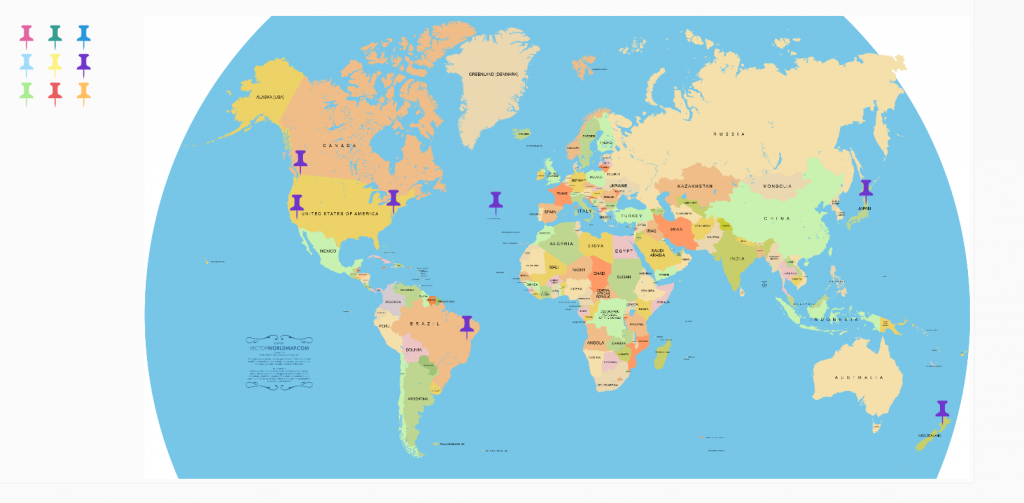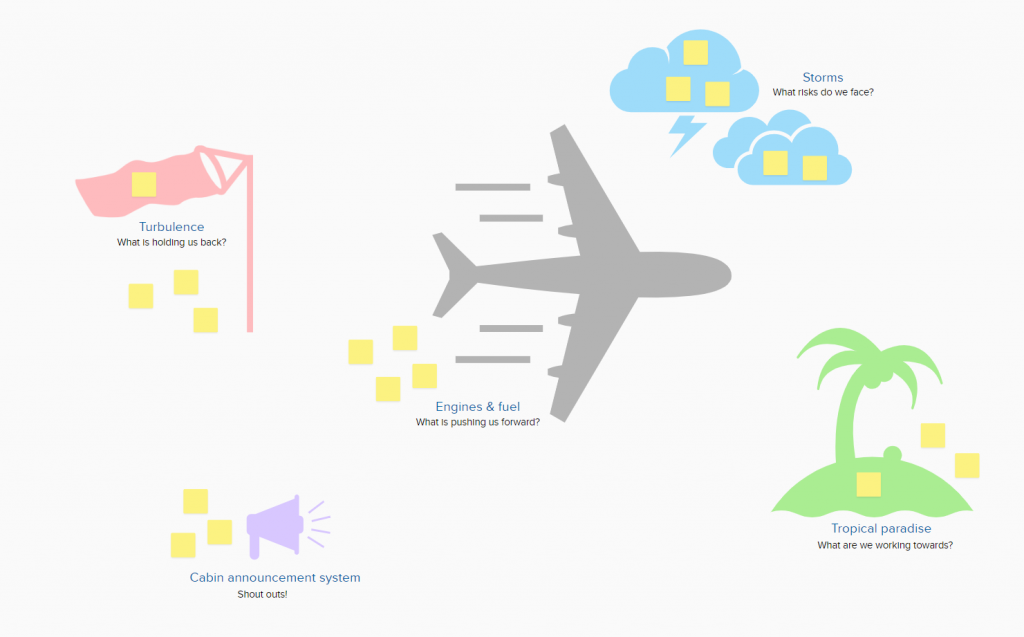Retro recipe
Please fasten your seatbelts and prepare for takeoff!

Good afternoon, passengers. This is your captain speaking. Welcome aboard Flight SLC33 bound for Paradise.
In this retrospective, you’re inviting the team to join you on an imaginary airplane ride to a tropical paradise. Hopefully, we won’t encounter too much turbulence or even thunderstorms, as our destination promises sunny skies, palm trees, and tranquil beaches. Enjoy this virtual journey with your team!
Ingredients
- An internet-connected device for all participants
- Video call software for all participants
- (Free) Mural account for all participants
- The Mural template
- Your awesome team
This recipe is tailored for a fully remote team, where each participant joins a video call and has their own device available, along with access to Mural.
At the end of the recipe, you'll also find adaptations for offline or hybrid meeting formats.
Remember to adjust the recipe based on your team's specific needs and preferences.
Retrospective (1h30)
Boarding - Setting the scene (5 min)
We are cleared for takeoff; however, I'd like to take a moment to go over some important safety instructions.
After confirming that all team members have joined the video call and can access the Mural board, you can set some ground rules with the team to establish a safe and open environment where everyone's opinions and perspectives are respected. These rules may vary depending on the Agile maturity of the team. Encourage the team members to actively participate and be honest and transparent. It will help ensure that your team gets the most value out of the retrospective.
Takeoff – Warm-up (15 min)
"If you could go anywhere in the world, where would you go?"

The team members will have a few minutes to think about this question. On the world map, they can then place a pin on the location they would love to visit. Once all pins have been placed, the team members can explain their choice or ask questions about others' preferences. They can discuss whether they have been to that place before and share interesting travel stories. However, do keep track of time to ensure the discussion remains within the allotted timeframe.
Cruising – Reflection (45 min)
This is your captain speaking again.
We are currently cruising at an altitude of 33,000 feet, maintaining a steady airspeed of 400 miles per hour.
However, I must inform you that we might encounter some turbulence and thunderstorms along our route. Rest assured that our aircraft is equipped with strong and reliable engines, and we will navigate through these weather conditions and get safely to our destination.

Let’s take a moment to reflect on the past sprint. To guide the team members, there are five main topics to focus on.
- Engines and fuel: What factors or aspects have been driving us forward and keeping our progress steady?
- Tropical paradise: What is the ultimate goal or vision we are working toward as a team?
- Turbulence: What obstacles, challenges, or issues have been holding us back or causing difficulties?
- Storms: What risks or potential setbacks do we anticipate or face in our work?
- Cabin announcement system: Take this opportunity to give shout-outs or express appreciation to team members for their contributions, support, or any noteworthy achievements.
Allocate about 10-15 minutes to individual reflection on the past sprint. Encourage everyone to jot down any thoughts related to these five topics on sticky notes. Each sticky note should be placed under the corresponding topic. Depending on how much they are writing and adding new sticky notes, you can adjust the timing a bit. Afterwards, the notes are discussed with the team.
By reflecting on these aspects and capturing their thoughts on the sticky notes, the team can gain valuable insights into their performance. This exercise helps identify areas for improvement, allowing the team to act and enhance their future outcome. Additionally, it provides an opportunity to acknowledge and appreciate the efforts and contributions of team members.
Baggage claim – Action points (20 min)
Please remember to collect your luggage before leaving the aircraft!
During or after the discussion of the different interpretations of the different topics, the team formulates actions that they need to start, stop, or continue doing. These actions can be grouped using the three colored suitcases and should aim to improve their processes and tools, bringing the team closer to their ideal sprint.
If there are numerous action points, try to prioritize them based on the team's decision, allowing them to focus on the most important ones.

Disembarkation – Rate the retro (5 min)
Ladies and gentlemen, we hope you enjoyed your flight with us today. We value your feedback and would greatly appreciate it if you could take a moment to rate your flight experience.
Lastly, it's time for the team to rate how the retrospective went. Hopefully, the team had a great session, and you can see it by the stars they give. They rate the retro from 1 to 5. This is also a chance to talk about what they liked and didn't like about the format, what went well, and what needs some work for your next retrospective.
Follow-up
The topics and action points discussed and mentioned during the retrospective hold great value, but they will be wasted if they remain untouched on the Mural board.
Often, the team will already have a main location to place the retrospective notes. Pay close attention to the action points and consider highlighting them or placing them in a separate section. To ensure their effectiveness, follow up on the action points, take the necessary actions, and track progress. Revisit them in the next retrospective to assess their implementation and discuss any outcomes or insights gained. By doing so, you can maximize the impact of the retrospective and drive positive change within the team.
Tips for an offline or hybrid retrospective
This recipe can also be adapted for fully offline sessions or a hybrid combination of online and offline elements.
Tips for offline adaptation
- For offline meetings, replace the Mural with physical materials such as sticky notes, whiteboards, or flip charts. Depending on your setup, you can still project a world map to provide inspiration for the warm-up.
- Print the five topic icons and display them in your meeting room. Team members can use real sticky notes and pens to write down their thoughts.
- Allocate a designated space for writing down action points. Use three columns to categorize the action points: start, stop, and continue.
- An offline team can rate the retrospective by raising their hand and showing a specific number of fingers on the count of three, representing the number of stars they would give the retro.
Tips for hybrid adaptation
This adaptation is suitable for organizing a hybrid retrospective where some team members attend the meeting in person while others join remotely via conference call. We assume that the facilitator is also present on site. Here are some key considerations:
- Ensure that there is a good-quality camera and microphone on site to facilitate clear communication between remote and in-person participants. Remote participants should also have their webcams enabled.
- The team members who are physically present only need one laptop with the camera pointed at the group. This laptop will join the video call, allowing remote members to join as well. The facilitator should share the Mural board so that everyone can follow along.
- The remote participants can add virtual sticky notes, while the on-site members can follow the tips for offline adaptation.
- As facilitator, it will be your job to read out the notes, alternating between physical and remote. This will allow coherence and ensure they’re all paid attention to.
- Action points can be added by the facilitator or by someone assigned to the Mural as they are formulated.
- For the rating of the retro, you can let participants vote by raising their hand either in person or to the webcam.